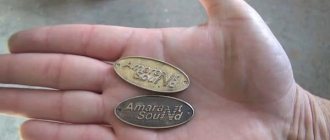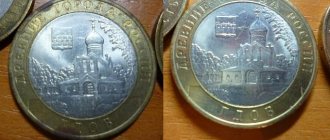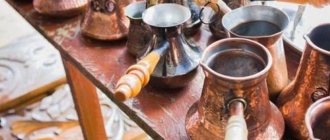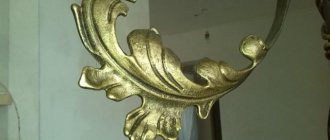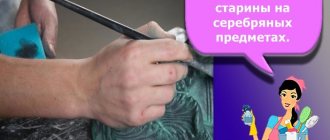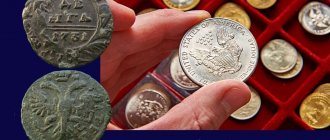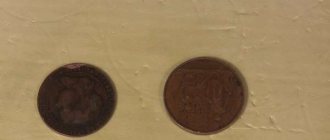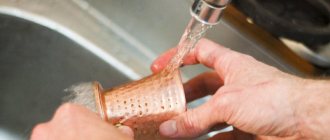The fabulous charm of the ancient cities of Europe is given not only by the exquisite ancient architecture, but also by the tops of the towers of an attractive green-blue color. This natural color of bronze is given by patina - a coating formed on copper, its alloys or other metals subject to oxidation. The bronze sheets that cover the domes and tops of the towers are initially dark brown in color. But after a few years, emerald islands begin to appear in the chocolate sea, which, growing, gradually hide the former color under a bright film.
The word “patina” comes to us from the Italian language, which inherited it from Latin, where patina is a small piece of utensils made of bronze. Oxidation processes create a patina consisting of many layers, but in conversations the word “patina” most often means only the top of them.
Not only dishes, but also coins were made from bronze. Therefore, people quickly became familiar with the patina on money. Patina is a natural and irreversible process. It can only be slowed down by preserving the item in an environment where oxidation will have an extremely gentle effect on it. That is why numismatists recommend storing coins in sealed capsules.
Types of patina
For collectors of modern anniversary items, patina is pure punishment. I almost forgot about the new bimetal or galvanized steel ten, and the stamped shine had already disappeared. Imperceptibly, the coin darkened and became dull. But patina sometimes transforms ancient coins for the better. Numismatists divide patina into several characteristic types:
- Natural – a layer of oxides on the surface of the coin;
- “Cabinet” – a smooth patina obtained by long-term storage of the coin in a wooden box or cabinet (a specialized cabinet for storing numismatic items);
- Rainbow – multi-colored patina;
- Bullet - a subtype of rainbow patina, when the colors change from light in the center to dark closer to the edge;
- Iridescent - a subtype of iridescent patina, when colors change depending on the viewing angle;
- Sandy - an even beige-yellow coating on coins that have been in the sand for a long time and exposed to silicic acid;
- Artificial - an induced layer to give the coin beauty and hide defects.
Above is a pair of royal coins that have begun to develop a natural patina. The first to change their shine to a matte color are the relief elements, which is especially noticeable on a penny. And, conversely, if the coin field is covered with patina, and the protruding elements look light (not patinated), then this is considered a defect called “cabinet wear.” A beautiful natural patina is highly prized and increases the value of the coin.
Artificial patina will be revealed by a thorough examination of the suspicious specimen. For example, it is clear that the patina lay over scratches and damage to the coin field or, on the contrary, did not cover its recesses. Unusual colors and shades of patina, as well as sharp transitions from color to color, should also raise suspicions. The yellow-brown smoky tint indicates that the patina was caused by tobacco smoke.
Rules and methods of patination
It's no secret that metals oxidize over time when exposed to air and water. But this happens differently for different alloys. If steel or iron is destroyed as a result of such exposure, then the copper is covered with a dark protective film. It is this layer that gives a special chic to antique items, indicating their authenticity.
Often, in the desire to remove dirt from a coin, it is subjected to mechanical processing, as a result of which the patina is also removed. It is quite possible to return the noble insignia after this. Often, artificial patination of copper coins is justified from an aesthetic point of view, since it helps to hide the results of their cleaning.
Required Tools
Depending on the chosen method of applying patina, it is necessary to prepare tools and materials. The minimum set includes:
- glass or plastic container;
- selected chemical reagent;
- beaker;
- stir sticks;
- synthetic brush;
- degreasing liquid;
- latex gloves;
- respirator;
- soap;
- sponge;
- unnecessary clean rags;
- cotton pads.
When all this is collected, you can begin the experiment.
Patina process
Of course, the presence of a “native” layer of oxides is much preferable, because it not only indicates the value of the specimen, but also reliably protects the coin from damage. If it is possible to preserve the natural plaque, then it is better not to touch it. When artificial aging is unavoidable, patina is applied independently. Patination is usually carried out using one of the following methods:
- dip coins into the prepared solution;
- place the monetary sample in a vapor-gas environment;
- apply the composition to the surface with a brush.
The quality of the final result directly depends on the method of obtaining the patina.
The quality of the final result directly depends on the method of obtaining the patina and on how well the coin was prepared.
First of all, the coins are cleaned of fat and oxides. This is done with a cotton pad soaked in white spirit or gasoline. These liquids are good at removing greasy marks that interfere with the oxidation process and the reaction of the patination solution with copper. It is also necessary to wear gloves, because... the patina will lie unevenly on fingerprints left behind.
Patina on copper coins
Most often, collectors are faced with the destructive effect of patina on copper coins. Its color depends on the storage conditions of the specimen. The characteristic green color is given to the coin by sulfates and sulfides formed on the surface of the metal. Coins extracted from the ground have a coal-black tint - this is copper oxide that has affected its deep layers. Bright green-blue islands are also not pleasing to experienced collectors, since they can move from affected coins to others.
Collectors love a smooth, monochromatic patina that is pleasing to the eye, where minor defects in the coin field cannot spoil the overall impression. It is this kind of patina that is often called “cabinet” or “noble”. Such coins are valued much higher than motley or spotted ones.
The patina on copper coins is important when grading. Together with the assessment of the degree of preservation, the expert often confirms one or another shade of copper: “BN” (Brown), “RD” (Red) and “RB” (Red Brown). This parameter, fixed on the weak, can also affect the price of the coin.
Types of patina depending on the alloy
Different metals oxidize differently, which means the type and color of the age-related plaque that appears is different. This is determined not only by the parameters and shelf life, but also by the composition of the alloy, including all its impurities. For example, if the composition contains even a tiny fraction of iron, the patina will have a characteristic reddish tint. It is the impurities that cause the appearance of an oxidizing film on coins made of precious metals.
The patina on silver coins is usually due to an admixture of copper, and gold money discs would have no traces of oxides at all without the presence of impurities, since gold of the highest standard is usually used for coinage, and it is practically not subject to oxidation. However, on gold specimens one can often observe dots or slight stains of a darker color (even brown), which indicates the presence of copper.
The first sign of patina on silver coins is a slight yellow coating, then it turns crimson, turns blue-green and finally becomes dark gray or almost black.
Patina on copper coins
The leader in the formation of oxide film is copper. Copper oxide has a color close to black, but can sometimes be a lighter brown. The well-known green color of aged copper is formed by its sulfides and sulfates. If loose deposits with a greenish tint appear on the surface, it means that we are dealing with copper chloride, which behaves the worst and destroys the metal in a short time, leaving deep marks after cleaning (“bronze disease”).
In addition, sagging has to be dealt with if the coin is artificially aged. And finally, there is another type of patina on copper coins, which is called “malachite”. It looks noble and beautiful, has an amazing blue-green color and is a thin crystalline layer.
Modern metal money
As for modern samples, which are based on stainless steel or a copper-nickel compound, their surface oxidizes slowly and weakly, the color of the coating varies from gray to copper-golden. Aluminum wheels lose their shine and acquire a dull grayish coating. Brass coins deteriorate very quickly, beginning to darken or lose color and becoming almost white after just a few months. Good storage can, in certain cases, slow down this process. When brass alloy is exposed to chemicals, it turns red.
Another type of modern coins is steel plated with non-ferrous metals. The slightest damage to the coating, almost invisible to the eye, causes a violent oxidation process, as a result of which the entire applied film swells and the metal underneath rusts. It is very doubtful that such coins will ever be able to acquire a noble appearance in old age.
Patina on coins made of copper alloys
Traditional tin bronze is close to copper in color. And since copper predominates in the alloy, the patina on bronze, despite the higher strength of the alloy, is similar to that formed on pure metal. As an example, we took a bronze coin from the late Roman Empire, on which bright inclusions of green-blue color are clearly visible. This is the formation of copper chloride (exposure to hydrochloric acid on the metal).
Soviet everyday coins of the older group of denominations (from 10 kopecks and above) were made from copper-nickel alloys cupronickel (until 1957 inclusive) and nickel silver (since 1961). Circular copies simply faded, becoming gray. If the coins fell into an aggressive environment (moisture or soil), the surface transformation process went faster. Copper plating of the coins occurred (copper protruding on the surface of the alloy), and the patina in appearance could resemble that formed on pure copper.
The junior group of denominations, from a kopeck to a nickel, was first minted from golden aluminum bronze and then from brass. Brass very quickly lost its original luster, darkening and tarnishing. The 1973 5 kopecks shown above show both an example that retains its stamp shine and a coin that has lost it.
From 2006 to 2014, Russian 10 and 50 kopeck coins were made from steel clad with tompak alloy (a type of brass). The coin shown above, although very dark, has acquired an unusual iridescent patina.
Method for cleaning copper coins | Numismatists Forum | Club Numismatist
Guys, read this, I collected this from different sites:Compounds of salt and sulfuric acid compounds in combination with moist air take part in the formation of stains on copper. If copper coins and medals have been in the ground, then please sign for the receipt of chlorides, green carbonates, black oxide and red copper oxide. First, you need to figure out what kind of oxides are on copper. Copper oxide is dark red. It can be removed with a 5%-10% solution of ammonium carbonate. If the oxides are dark green, then it is copper carbonate. It is removed from the coin with a 5%-10% citric acid solution. I have had to clean many copper coins with citric acid. Its main advantage is that it does not eat metallic copper. If you urgently need to clean a coin, then add 13 teaspoons of citric acid to a glass of warm water. Stir until dissolved. It works quite quickly, so you don’t have to go far. From time to time, mechanically treat the coin with a toothbrush and wooden toothpick. After cleaning, rinse well with running water. New way to clean copper: Fill dirty and shabby-looking copper coins with fresh kefir! Depending on the degree of contamination of the coins, the time they remain in kefir is up to one day. Clean them from time to time with a soft toothbrush. I cleaned many coins and medals with kefir. Besides the benefit, there is no harm. Attention! Any chemical cleaning of copper eats away natural and artificial patina!! Therefore, below I will tell you how to properly make artificial patina at home. Waiting for a strong patina to form on the copper itself is a thankless task. Here is my favorite patination recipe - a hodgepodge from the books of Farmakovsky and Vasilyeva. They also learned this at one time from Zograf and Anokhin, if I understood Anokhin correctly. I’ll warn you right away - I did it several times, varying the percentage of components. The patina is quite good. but not as beautiful as the factory one. Patination - (from patina - an oxide film formed as a result of oxidation on the surface of parts made of copper, bronze or brass) the process of artificially coloring the surfaces of parts made of brass, bronze and copper in light or dark shades of brown. Before applying an artistic patina to copper products, you must: 1) Treat (clean) copper products in a 5% solution of caustic soda, or in a 5% - 10% solution of ammonium carbonate. At the same time, copper salts and oxides soften, and most importantly, this process occurs gently, leaving metallic copper intact! Copper products must undergo a chemical cleaning process within a day or two. After which you need to: 2) Rinse the copper products well with running water. 3) Carry out mechanical treatment with a soft brass brush. In case of insufficient cleaning of the surface after mechanical treatment, send the copper products again to the cleaning chemical solution, and so on until the surface is completely cleaned. If you think that’s all, it’s not true. Clean surface? - Great! Now the next step is: 4) Boiling in several successive portions of distilled water to remove excess alkali. It is advisable to do this several times until the water becomes completely neutral. At this stage, you stop picking up the copper product with your hands. 5) Now it’s time to dry. Take your copper with tweezers. or something that does not leave marks on a clean surface, dangle the product in acetone for a couple of minutes, and forget about it, putting it in alcohol (technical, methyl, but preferably ethyl, drinking alcohol) for half an hour - an hour maximum. 6) If everything worked out for you, then dry the copper product in the air and you can start applying an artistic patina to it. Added (May 15, 2007, 20:49) ——————————————— Wear rubber gloves! Take care of your nail color from a young age!! For 1 liter of distilled water, 25-50 grams of copper sulfate and 3-5 grams of potassium permanganate. Stir well until dissolved and heat to 70-80 degrees Celsius and lower the copper products. The fewer components in the solution, the slower it works, but the smoother the patina layer. After patination and mandatory drying, canning is mandatory. There are options like acorns on an oak tree. Old method of patination: Usually patination is done chemically by immersing the part in a solution of liver sulfur (an alloy of sulfur and potash). Depending on the exposure time in the solution, different colors are obtained. For silver and copper medals, patination is also common, which destroys the shine of the metal, which prevents the details of the medal from being clearly distinguished. For this purpose, ammonium sulphide is used for silver medals, and for bronze and copper medals - mummy dissolved in water: the medal is dipped in a similar solution and then, after heating it, rubbed with hard brushes, which gives the patina obtained in this way a glossy surface. Remember! Everything needs a sense of proportion!! These technologies were invented by smart people who lived many years ago and have been tested for decades. Good luck!!!
Hello. Andrey! I don’t know what “horny silver” is, but for cleaning coins from a treasure (albeit Russian rubles), ordinary ammonia from a pharmacy worked great. If there are strong oxides, the coin is placed in an airtight container for 3-7 days, and from time to time it is taken out and cleaned with a toothbrush. I am very pleased and always treat silver this way. Added (November 27, 2006, 5:10 pm) ——————————————— And the copper in vegetable oil is refined. it also works out fine. It is not advisable to use ammonia on copper... As for the artificial patina on copper, try rubbing butter and sulfur ointment from the pharmacy in equal parts. It will be beautiful, but your fingers will be black and take a long time to wash)))) This method with AgCl will not work. The coin turns into trash. Ammonia will not work with horn silver. It completely changes the structure of the coin and the coin turns into dust (breaks when touched). I’m at the dawn of collecting, so I killed several Sheybanids of Serakhs. The apostle almost shed tears. It's a pity. Maybe some other method. And I usually throw silver into Trilon, and use the smallest dose, but hold it longer. As for the patina on copper, I use the usual light firing on a gas flame. Firstly, excess greenery burns out, and secondly (especially after chemical cleaning) the color can be adjusted. And after some time, the coin still darkens and the results of dry cleaning are not visible. By the way, who has mastered the book “Chemistry in Restoration”? I have it at home - I don’t have time to read it. Maybe there is something there. And cognac is good!! Regarding the patina on copper, I know about a gas stove; I collected copper myself for 15 years... Sulfur ointment is the best way, because... after the stove, the coin becomes dull and often takes on an unnatural color, and as for burning greenery - often the coin can simply be destroyed on the stove - this is how I killed the cloudy penny of St. Petersburg, although there were only a couple of small green spots - after the gas stove I ended up with two huge shells. Added (November 28, 2006, 11:02) ——————————————— Although... A coin with greenery (copper) is best cleaned mechanically, i.e. Using a scalpel or similar object, very carefully remove the EXTRA greenery from the coin, and then cover it with the same sulfur ointment and oil and sell it!! Keeping such a coin for yourself will only make you upset)))) I regularly get upset when I see a 5 kopeck IK 1727 Kd (this is rare) in my collection, which lives its own life after cleaning - it will turn green again, then a white coating will appear, or something else . Try putting it in refined vegetable oil for 3-4 days. In any case, you won’t spoil it... And during this time, maybe someone will advise something. So, that's it, guys. This method was described, they say, by Markov and the revolution. I haven’t used it myself, but one cunning Burzhin guy... you all probably know him... recommended it and says it works well. The coin is wrapped in several layers of aluminum foil. Take a strip slightly wider than a coin and wrap it in 4-5 layers. But so that both edges remain open. The foil should fit tightly to the coin, and the edges should remain open, clear, right? Place in a glass and pour in undiluted vinegar (I believe that in translation from bourgeois, undiluted vinegar can mean essence, but I don’t insist...) So that the solution covers the package by a quarter of an inch, he says, that is, 6 mm that way... Usually, he says, it takes a day so that everything works. There, it seems that a current is formed between the coin and the aluminum, and this is what cleans the horn silver. A sign that it’s time to open - he says - the foil has been eaten. And Rasmir - the cognac is poured! :-)) Although I personally would prefer to throw it before the process. Today I cleaned small silver items from the late Jochids, Girays and early Ottomans. There were four types of contamination: 1) black silver sulfide; 2) bright green copper chloride - low-grade coins; 3) gray-yellow loose film - I suspect that it is also some kind of impurity, lead, for example; 4) a dense dark gray coating - was on two rather high-grade coins that were probably lying in the ground; I think it's a silver compound. After reading the following post, I came to the conclusion that (4) is probably horny silver aka silver chloride. First, I put everything in a 5% formic acid solution for an hour. It is stronger than vinegar and, unlike lemon, is volatile, so it does not remain on the coin. After that, I washed it with my fingers under running water. Contaminants 1 and 3 came off quickly and beautifully. True, it turned out too brilliant, many people don’t like it that way, but without shells. The greenery (2) also came off, but left shells, but small and shallow, so the appearance was not affected. Only two coins with a dark gray coating (4) were not washed. The plaque brightened, but did not go away. I put them in a 5-10% ammonia solution (ammonia). After an hour of incubation, I took baking soda (sodium carbonate) and added ammonia to it to form a thick paste. I applied this paste to the surface of the coin and rubbed it, not sparing my fingers. One came away easily and beautifully. The second one took a long time, about 5-10 minutes, and micro-shells remained on the coin. The field turned out matte, the relief was without noticeable damage. I'm pleased with the result. With copper, it’s clear that it doesn’t work out that easy. I came to the conclusion that when it comes to copper we need to move from chemistry to mechanics. Fortunately, the binocular is available, however, there is nowhere to put it at home. Comrades, I will tell you my method of cleaning horn silver. By which we usually mean its chloride, which has the appearance of a very dense coating, dark gray in color, often with a purple tint. Take potassium thiocyanate or ammonium thiocyanate - KSCN or NH4SCN. The first one is slightly better. These are salt-type crystals, somewhat hygroscopic, loose, pinkish in color. The reagent is dissolved in water, and the coin is kept in it in a steam bath. Concentration - ... stronger. Well, there is not much difference, if the solution is weak, it will work very slowly, and if the solution is strong, it will work simply slowly. There are no harmful fumes, but it’s probably not worth trying to taste.. If you don’t have time, you can just stick it in there and look at it from time to time. The process is slow. May take from several hours to several days. Or more. If more, change the solution. Periodically rinse the coin under running water and wipe it with a clean white cotton or linen cloth - you will see how the heavily blackened coating of horny silver comes off. A soft brush, maybe a touch of a scalpel sometimes... that’s it, the coin will be great. I use this for very expensive coins. Didn't spoil any of them. No special caution is needed, just attention and patience. Anyone who tries it, please give feedback! maybe, maybe - the question is - where can I get that thing with the most butted, sorry, rodanium pulpit? Usually, silver can be cleaned normally - hydrochloric acid - washing - ammonia, with cleaning with soda. But among the Jochids there are particularly harmful specimens - which even after this remain covered with black thin spots of film. This is still an unsolvable task for me. As for the ammonia, I categorically DO NOT recommend putting more than one contaminated coin there - there is a chemical between them. some kind of process and a dull white layer appears, sometimes in spots - real minor corrosion. I ran into myself once when I loaded a couple of dozen coins into the jar in one fell swoop. According to the law of meanness, the most valuable ones naturally suffered the most. Here is the technology for cleaning silver coins that I received many years ago from Zograf and Anokhin: “The formic acid solution should be 10% - 20% and heated to 60 degrees Celsius. Keep the coin in it until the oxides are completely dissolved, after which you can walk over the coin with a soft toothbrush with natural bristles. When all the oxides have disappeared, boil the coin twice in distilled water, wipe dry with a cotton cloth and lightly rub the coin with a red ink eraser. After that, we put the coin in pure ethyl alcohol for half an hour, dry it in air, and you can cover the coin with a thin layer of paraffin, protecting it from hydrogen sulfide in the air. » To clean horny silver, use ammonium chloride NH4Cl (aka ammonia in powder), and then everything is as geserkhan wrote above. If anyone is interested in the technology for cleaning copper coins, I can share. »Formic acid solution should be 10% - 20% and heated to 60 degrees Celsius. Keep the coin in it until the oxides are completely dissolved, after which you can walk over the coin with a soft toothbrush with natural bristles. When all the oxides have disappeared, boil the coin twice in distilled water, wipe dry with a cotton cloth and lightly rub the coin with a red ink eraser. Maybe, maybe, just for Christ's sake, no eraser - neither red nor white - the stamp shine will go away instantly. Well, I do a great job of adding shine with a white eraser. I tried everything. but it turns out to be an active toilet duckling. Comrades, I will tell you my method of cleaning horn silver. By which we usually mean its chloride, which has the appearance of a very dense coating, dark gray in color, often with a purple tint. Take potassium thiocyanate or ammonium thiocyanate - KSCN or NH4SCN. The first one is slightly better. These are salt-type crystals, somewhat hygroscopic, loose, pinkish in color. The reagent is dissolved in water, and the coin is kept in it in a steam bath. Concentration - ... stronger. Well, there is not much difference, if the solution is weak, it will work very slowly, and if the solution is strong, it will work simply slowly. There are no harmful fumes, but it’s probably not worth trying to taste.. If you don’t have time, you can just stick it in there and look at it from time to time. The process is slow. May take from several hours to several days. Or more. If more, change the solution. Periodically rinse the coin under running water and wipe it with a clean white cotton or linen cloth - you will see how the heavily blackened coating of horny silver comes off. A soft brush, maybe a touch of a scalpel sometimes... that’s it, the coin will be great. I use this for very expensive coins. Didn't spoil any of them. No special caution is needed, just attention and patience. Anyone who tries it, please give feedback! I found ammonium thiocyanate in our laboratory, I want to try it. What concentration of the solution would you recommend? At least approximately, in teaspoons per glass of water. By the way, I want to warn everyone - this reagent is, in fact, far from harmless! It can cause burns to mucous membranes and skin - I advise you to wear gloves. And most importantly - under no circumstances allow acid to get into the solution! This releases gas (HSCN), which belongs to the category of chemical warfare agents, along with hydrocyanic acid. Allow me a few words from myself. I successfully bathe copper in distillate and help with a wooden toothpick. The method is VERY long, but the result sometimes exceeds your wildest expectations. Sometimes, however, it is ineffective at all. Applicable only to very favorite coins :))). Once I ruined a couple of Russian coppers. 2 and 3 kopecks from the 1860s. I decided that if they were from the same mint and minted a year apart, they should not affect each other, certainly in the distillate. An - no. The lime loosened and the shells became empty, but at the point of contact the coins became lilac and glossy. Is it true. I haven’t touched them for probably 3 months :))) Silver - with olive oil. There were no problems with subsequent odor. Somehow I even successfully cleaned up the fact that they didn’t take ammonia and soda. Regarding the latter: I somehow spoiled Gireev’s billon by vigorously rubbing the entire side with soda just with my fingers. The protruding parts have become completely pink :( A toothbrush plus a toothpick for local exposure to the same soda does not do this. Friends, I want to share with you advice on cleaning silver and copper coins. Believe me, electrolysis has been tested and tested.. I have cleaned different coins using this method , including ancient Rome, the Timurids, etc. The result is stunning. The main thing is not to use a homemade product, but to purchase a patented device + a special mixture for diluting the solution. Under no circumstances use table salt, as many advise. Coins, if any oxide and greenery turn out just super. The patina and other advantages are all in place and most importantly, not for long, from a few minutes to a few hours. Coins that many simply throw away are unrecognizable after cleaning. Here is a photo of a Roman coin, it was a piece of greenery that was absolutely undetectable, here is the result. Good luck.
[ Reply >> ]
Patina on silver coins
Iridescent patina on silver coins can be found much more often than on copper. Previously, such a variety of colors could greatly increase the price, since such a specimen looked very advantageous against the background of ordinary coins, even if they had a stamp shine. Nowadays, there are many ways to create a rainbow patina. However, the artificial patina stands out with bright, unnatural colors that scare off experienced collectors and attract only beginners.
Let's look at the classic bullet patina. Its name comes from the similarity of the coin, which has such a patina, to one of the types of bullet targets. The coin field of the Soviet silver fifty-kopeck piece shown above contains smooth transitions of patina from light to dark tones, like on a target.
Tsarist and early Soviet bilon coins are 500-carat silver. The alloying additive to the precious metal is copper. Due to its presence, a thin layer of silver sulfide may form on the coin - a malachite-colored patina. It reduces, rather than increases, the price of the coin, so they are trying to remove it.
Patina on gold coins
Pure gold is a metal that is practically not subject to oxidation. This section appeared only because pure gold was not used for everyday coins of past centuries because of its softness. To give gold strength, it was alloyed with a small amount of other metals (usually silver and copper, less often nickel or molybdenum). The five-ruble note of Nicholas II, taken as an example, is 900-carat gold. The alloying additive to it is still the same copper. Under certain conditions, copper can appear on the surface, and even such a small amount will cause the coin to darken in fragments (as in the illustration above).
More often on gold you can find rust stains, caused by the same oxidation process. During minting, chipped microparticles of the stamp may become pressed into the surface of the gold, and after a few years the coin will become unsightly. In Russian numismatics, the most famous are the rusty gold “Victory Bearers”. After the scandal with SPMD gold coins, Russian minting technology was improved, and such defects began to occur much less frequently. Both rust and patina always reduce the value of gold coins.
What is patina?
The word “patina” is of Italian origin, in which it has a general meaning: the formation of plaque, an oxide film on any surface of any material under the influence of environmental factors. It can appear on anything, even on a stone. In essence, this is the same as rust, which iron is susceptible to; the only difference is in the chemical structure, which is determined by the chemical composition of the object itself (in this case, the metal). If rust appears on iron, then patina forms on copper, silver and other non-ferrous metals.
Patina on aluminum coins
Aluminum was often used in coinage in the 20th century. Basically, small denominations were made from it (for example, Hungarian fillers). In the GDR, the entire line of coins, with the exception of the heavy brass 20 pfennig used in the machines, was aluminum. The oxidation process quickly deprives the aluminum coin of its stamp shine. It becomes dull and inconspicuous, acquiring a matte gray coating. And if the protruding parts of the relief are still mechanically cleaned during circulation, then the coin field very soon begins to look dirty.
Patina on zinc coins
Zinc patinated coins have the most deplorable appearance. Shown above is a selection of small denominations from Denmark, the Netherlands and Luxembourg from the First and Second World Wars. In difficult times, metal becomes a strategic raw material, so coins have to be made from the cheapest material. Patina causes zinc coins to darken to such an extent that it is sometimes difficult to make out the designs and inscriptions on them. It is not surprising that after economic recovery, all these countries abandoned zinc coins, choosing other metals and alloys.
Do I need to remove the patina?
This question is often asked by beginners. There is no clear answer to this. As we have already found out, a beautiful, uniform patina gives antique coins a noble appearance, emphasizing their age and authenticity. The same applies to the iridescent patina, which does not hurt the eyes. But the black and purple sagging on silver coins (they are also called “horn silver”) greatly spoils the impression. The most difficult situation is with copper. If the patina goes deep, then during the cleaning process the coin risks turning into a thin circle or even falling apart. But even removing the surface layer often changes the specimen beyond recognition. Patina is part of the coin. Removing it leads to “blurring” of the relief. The field, which previously looked smooth, turns into a collection of holes and ruts. Cleaning copper will never return it to its original appearance, which is what many people hope for when undertaking this process. Experienced collectors recommend removing patina only in cases where it is guaranteed to improve the appearance of the coin.
Patina is not acceptable on Proof quality collectible coins. However, under incorrect storage conditions (without a capsule or in a damaged seal), both silver and copper-nickel gradually become covered with a whitish patina. Sometimes the patina can even change the color of the coin, turning it brown, yellow or beige. Cleaning “Proof” coins from patina is allowed only with the help of a specialized liquid without mechanical impact, otherwise the mirror field will be irrevocably damaged by micro-scratches.
Artificial patina
The high value of ancient coins often serves as a reason for artificially inducing signs of age. This is not always done for the purpose of unjust enrichment. For example, artificial aging is used when creating official copies or after cleaning, which results in an unnatural color for the metal or a shine inappropriate for the age of the coin. In addition, patina is applied to visually hide some physical defects as a result of regular use or improper storage. In any case, artificial “old age” with a certain skill can be easily distinguished from natural one, no matter how beautiful the result looks. There are several ways to obtain it.
Touch up
On the scale of professionalism in creating artificial patina, this method is at the lowest level and is applicable only for the mass production of cheap copies. The first obvious sign of a fake is shine, which should not be present in the genuine case, a thick layer of plaque and its sharp drop in places where the transition to the center should be very smooth. However, it is possible to deceive completely ignorant people with such fakes.
Burning
To give the coin disc an old look, it is heated over an open fire of any type - a gas burner, a blowtorch, a fire, etc. Another short-sighted technique, since the difference is too obvious.
Chemical methods
They can be different, but they come down to simulating conditions that provoke an accelerated aging process. The inventions of entertainers are endless; here are just a few examples:
- A solution of copper sulfate and potassium permanganate based on distilled or simply boiled water, heated below the boiling point. The coin is lowered into it for a short time (a couple of minutes).
- Rubbing with sulfuric ointment followed by rinsing in a solution of ordinary laundry soap.
- Immersion in any sulfuric solution or in sulfuric acid itself. Even ordinary match sulfur is used. The impact is very strong and fast. But the result is easily recognizable.
"Folk art"
The same can be said about it as about chemical experiments, with the difference that natural aggressive environments are used without the use of active substances. These are all kinds of combinations of temperature influences, humid air, water and even food (an example is baking a coin in a potato). Sometimes it is possible to obtain good results, which, however, are clearly distinguishable from the originals by specialists. But without the proper skill, most often the result is a hopelessly damaged coin.
Patination of coins
Collectors who have started cleaning copper coins find that after removing the patina, the copper acquires an unpleasant reddish-scarlet tint. To give the coin a decent appearance, they resort to artificial patination. Conservative methods involve keeping the coin in oak boards, in sunlight or in the vicinity of sulfur, for example, in a jar with a scattering of matches. But craftsmen also know how to quickly create a patina using ammonia, ammonia, manganese and copper sulfate. The use of sulfur ointment has already become classic for copper coins. Coins are also burned and then covered with a layer of baby cream, but most collectors consider this method barbaric. Manufacturers of numismatics products, of course, have not left this niche empty, offering liquids for creating patina on various metals.
Each collector makes his own choice of which coins to choose for his exhibition: exclusively in stamped shine, cleared of patina or, conversely, only with its presence. And yet, if you come across a specimen with a beautiful and even patina, do not try to immediately remove it. Perhaps it is waiting for its connoisseur, who will consider the coin with it an amazing work of numismatic art.
